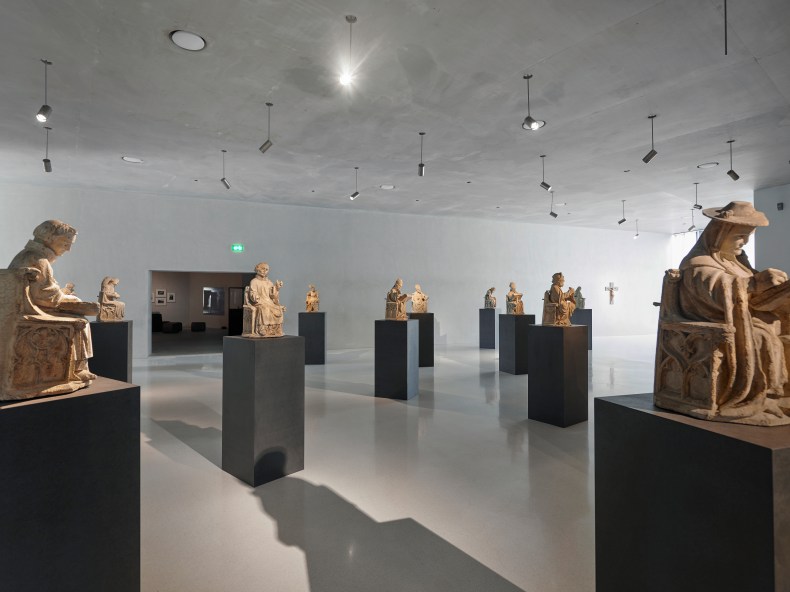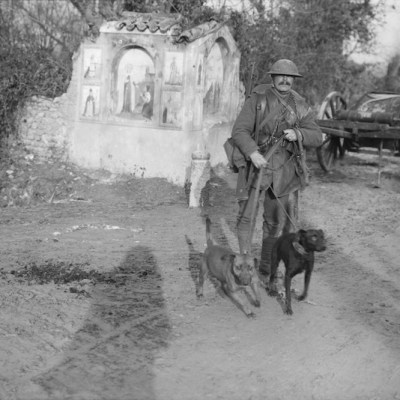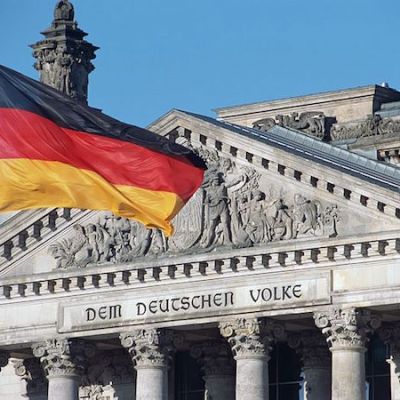On the night of 30 May 1942, Air Marshal Arthur Harris, Commander-in-Chief of Royal Air Force Bomber Command, launched the first of his 1,000-bomber raids on Nazi Germany. The target was the ancient city of Cologne. By the following morning a sixth of the city’s homes were damaged or destroyed. But this terrifying raid was neither the first nor the last Cologne would suffer. By April 1945, when hostilities ceased, there had been 262 attacks, which destroyed most of the city’s buildings. The great cathedral by the Rhine with its twin spires – that masterpiece of both medieval and Gothic Revival architecture – still stood, gravely damaged, as did the (unfortunately) adjacent central railway station, but most of the famous Romanesque churches were partly or completely demolished. Mercifully, the works of art and the stained glass windows in the cathedral had been taken out and kept safe, as had most of the contents of the city’s museums and art galleries.
The official report, Works of Art in Germany (British Zone of Occupation): Losses and Survivals in the War (H.M.S.O., 1946), stated that ‘The devastation in Cologne has been very great and covers the entire city.’ The German architect Rudolf Schwarz, who prepared a master plan for rebuilding in 1947, described Cologne as ‘the world’s greatest heap of rubble’. Today the city has been rebuilt, but the result is disappointing – neither a careful restoration of past glories nor a compelling new vision. The density is too low, and Cologne feels more like a post-war New Town than a historic riverside fortress city founded by the Romans. By far the most impressive new buildings are the city’s museums and art galleries, which contain collections of breathtaking quality and richness. The oldest is the Wallraf-Richartz Museum; its first purpose-built home opened in 1861 and it is now in a building by O.M. Ungers that was completed in 2001. At one stage, it shared with the Ludwig Museum a building designed by Peter Busmann and Godfrid Haberer, which opened in 1986 and housed both institutions until the city council chose to divide them in the 1990s. And then there is the Römisch-Germanisches Museum by the cathedral, by Klaus Renner and Heinz Röcke, which opened its doors in 1974.
The most recent of the buildings housing Cologne’s art and artefacts is perhaps the most intriguing, partly because it is at once a museum, a church, and an ancient ruin, and so expresses much about the city’s tragic modern history. This is Kolumba, which opened in 2007, taking its name from the church dedicated to the eponymous saint that stood on the site. It contains the collection of the Catholic Archdiocese and is the successor to a museum founded in 1853 by the Christlicher Kunstvereins für das Erzbistum Köln (Christian Societies for the Promotion of Fine Arts in the Archbishopric of Cologne), which was housed in a building opposite the south transept of the cathedral that was obliterated in the war. A competition for a new building was held in 1997 and won by the Swiss architect Peter Zumthor.
Zumthor came to international attention with his spa buildings at Vals. Born in Basel in 1943, the son of a cabinetmaker, he was first apprenticed to a carpenter. Perhaps in consequence, his work is characterised by a sensuous delight in the colour and properties of materials. His office is comparatively small and he is known for his deep, perhaps obsessive involvement in every aspect of a project. Today he is something of a cult figure, but although he has collected the usual gongs – the Pritzker Prize in 2009; the RIBA’s Royal Gold Medal in 2013 – he is very different in his attitudes and morality to the vaunted ‘starchitects’. Few of them would be likely to claim, as Zumthor has done, that ‘I select my clients based on the simple criteria of whether the project is worthwhile socially or culturally; whether I would like to do it; and whether the client has some kind of good intention other than making money […] I think this has nothing to do with arrogance – it is the way I have always been. I’ve always said yes, or no, without looking at the money.’ In some ways he can therefore be regarded as a modern equivalent of the English Arts & Crafts architect Philip Webb.
The ground floor of Kolumba, showing the ruins of St Kolumba and the chapel for the Madonna of the Ruins. Courtesy Kolumba

St Kolumba’s Church – gothic not Romanesque – was almost completely destroyed in the war and not rebuilt. Instead, a much smaller new church was built in 1947–50 on a small part of the site; it contains a late gothic statue found largely intact in the rubble, now known as the Madonna of the Ruins, as well as many modern artworks. This was later extended, in 1952–58, by an extraordinary, inventive Chapel of the Holy Sacrament. Both were early independent works designed by Gottfried Böhm (b. 1920), the son of the architect Dominikus Böhm (whose centrally planned Church of St Engelbert of 1928–32 in the Cologne suburb of Riehl is one of the great modern churches of its time). And both this very powerful and moving new church and the remains of its several predecessors were enclosed and integrated into the new building by Zumthor.
Kolumba stands on a corner. Its pre-history is immediately indicated by sections of surviving medieval wall and windows that are built into the towering new walls of special grey bricks, laid with flush mortar. Zumthor’s walls rise from the street lines to reach straight parapets at different levels, so making the new museum a properly urban as well as a monumental structure. Large rectangular windows, high up, suggest the internal spaces. But what is intriguing is the different texture of wide bands of the brickwork. These turn out to be openings between bricks, which allow a dim, filtered light to illuminate the space behind – a huge covered area that is a sort of archaeological site, in which a jagged walkway runs over the ancient foundations and fragments and allows dramatic views of the polygonal exterior of Böhm’s church.
14th-century stone figures from the archivolt of the St Peter Portal, Cologne Cathedral, displayed in a gallery at Kolumba. Courtesy Kolumba

The museum has a separate entrance from the church, and its interior is very different. From a small lobby, overlooking a courtyard that was once a cemetery, a narrow, monumental staircase rises between sheer brick walls to reach two floors of exhibition space. These consist of rooms of different shapes and sizes, each naturally lit, which provide an austere setting for works of art both ancient and modern. All come from the Kolumba collection, but the modern displays change. On the second floor, in a large space, are 34 original sculptures (since replaced by replicas) from the archivolt curves from the 14th-century St Peter Portal of the cathedral, and it is wonderful to be able to see these at close quarters.
Beyond this, on a corner, is a room that contains the Four Crowned Martyrs, four stone figures that, although ostensibly sculptors martyred by Diocletian because they would not carve heathen idols, in fact depict masons who worked on the cathedral (in the current ‘On the Individual’ display, which continues until 14 August). Carved by the master mason Konrad Kuyn as a memorial to his predecessor, these are clearly portraits of real men, carrying the instruments of their profession; after careful restoration, they now show their original colouring. These most engaging figures are lit by a large floor-to-ceiling window through which can be seen, above the rooftops, the great gothic cathedral for which so many of the exquisite works of religious art in Kolumba were originally made. Past and present are brilliantly combined in this most subtle of modern museums.
From the June issue of Apollo. Preview and subscribe here.



